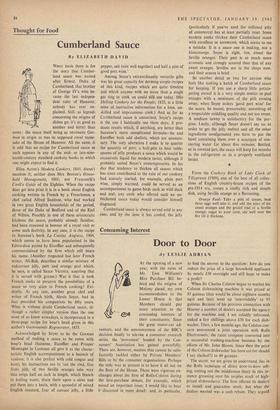Thought for Food
Cumberland Sauce
By ELIZABETH DAVID
Eliza Acton's Modern Cookery, 1845, doesn't mention it; neither does Mrs. Becton's House- hold Management, 1861; nor Francatelli's Cook's Guide of the Eighties. When the recipe does get into print it is in a book about English cooking written in French by a Frenchman, a chef called Alfred Suzanne, who had worked in two great English households of the period, those of the Duke of Bedford and of the Earl of Wilton. Possibly in one of these aristocratic kitchens the sauce, probably already familiar, had been renamed in honour of a royal visit or some such festivity. In any case, it is the recipe in Suzanne's book La Cuisine Anglaise, 1904, which seems to have been popularised in the Edwardian period by Escoffier and subsequently commercialised by the firm which still bears his name. (Another respected but later French writer, Ali-Bab, describes a similar mixture of redcurrant jelly, port and orange peel which, he says, is called Sauce Victoria, asserting that it is served with grouse.) Was it that it took French cooks to perceive the possibilities of a sauce so very alien to French cooking? Evi- dently. At any rate, another great chef and writer of French birth, Alexis Soyer, had in fact preceded his compatriots by fifty years. What is without doubt Cumberland sauce, al- though a rather simpler version than the one most of us know nowadays, is incorporated in a three-page recipe for boar's head given in this author's Gastronomic Regenerator, 1853.
Acknowledged by Soyer to be the German method of making a sauce to be eaten with boar's head (Suzanne, Escoffier and Prosper Montagne' in Larousse all give it as the charac- teristic English accompaniment to a haunch of venison; it is also perfect with cold tongue and ham), his instructions are to 'cut the rind, free from pith, of two Seville oranges into very thin strips half an inch in length, which blanch in boiling water, drain them upon a sieve and pat them into a basin, with a spoonful of mixed English mustard, four of currant jelly, a little pepper, salt (mix well together) and half a pint of good port wine.'
Among Soyer's extraordinarily versatile gifts was his great capacity for devising simple recipes of this kind, recipes which are quite timeless and which anyone with no more than a single gas ring to cook on could still use today. (His Shilling Cookery for the People, 1855, is a little mine of instructive information for a lone, un- skilled and impecunious cook.) And as far as Cumberland sauce is concerned, Soyer's recipe is the one I habitually use these days; it pro- duces results which, if anything, are better than Suzanne's more complicated formula—he and Escoffier both add shallots, which are unneces- sary. The only alteration I make is to quarter the quantity of port; a half-pint to four table- spoons of jelly produces a sauce which would be excessively liquid for modern tastes, although it probably suited Soyer's contemporaries. In his day that tendency to thicken all sauces which has since contributed to the ruin of our cookery had scarcely started; for example, plain port wine, simply warmed, could be served as an accompaniment to game birds such as wild duck and teal; any cook who offered such an un- thickened sauce today would consider himself disgraced.
Cumberland sauce is always served cold in any case, and by the time it has cooled, the jelly
(particularly if you've used the stiffened jelly of commerce) has at least partially reset. Some modern cooks thicken their Cumberland sauce with cornflour or arrowroot, which seems to me a mistake. It is a sauce one is making, not a blancmange. Soyer is right, too, about the Seville oranges. Their peel is so much more aromatic and strongly scented than that of any sweet oranges. Sevilles are in the shops now, and their season is brief.
So another detail or two for anyone who feels like making a batch of Cumberland sauce for keeping. If you use a sharp little potato- paring utensil it is a very simple matter to peel oranges with a minimum of the pith coming away; when Soyer orders 'good port wine' for the sauce, he meant, presumably, something of a respectable middling quality and not too sweet. A medium tawny is satisfactory for the pur- pose. Lastly, although Soyer doesn't say so, in order to get the jelly melted and all the other ingredients amalgamated you have to put the bowl containing them over a saucepan of sim- mering water for about five minutes. Bottled, or in covered jars, the sauce will keep for months in the refrigerator or in a properly ventilated larder.
From the Cookery Book of Lady Clark of Tillypronie (1909), one of the best of all collec- tions of English country-house recipes of the pre-1914 era, comes a coolly rich and simple dish, using Seville orange as a flavouring.
Orange Fool: Take a pint of cream, beat
three eggs well into it, and add the juice of six sweet oranges and the grated rind of a Seville orange; sugar to your taste, stir well over the fire till it thickens.


































 Previous page
Previous page